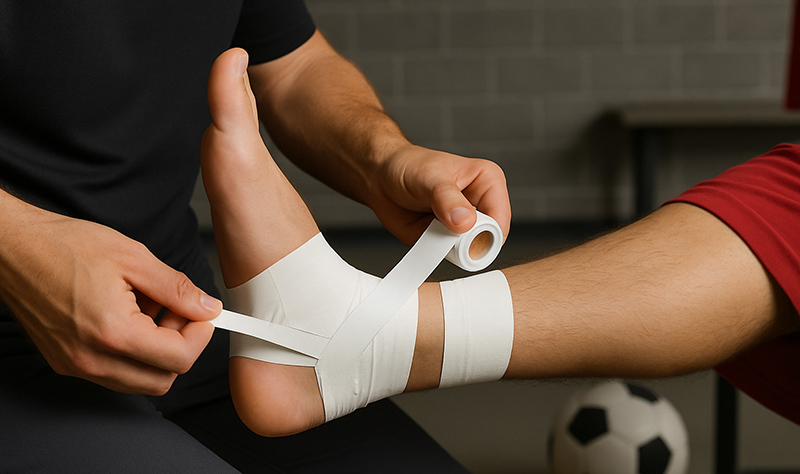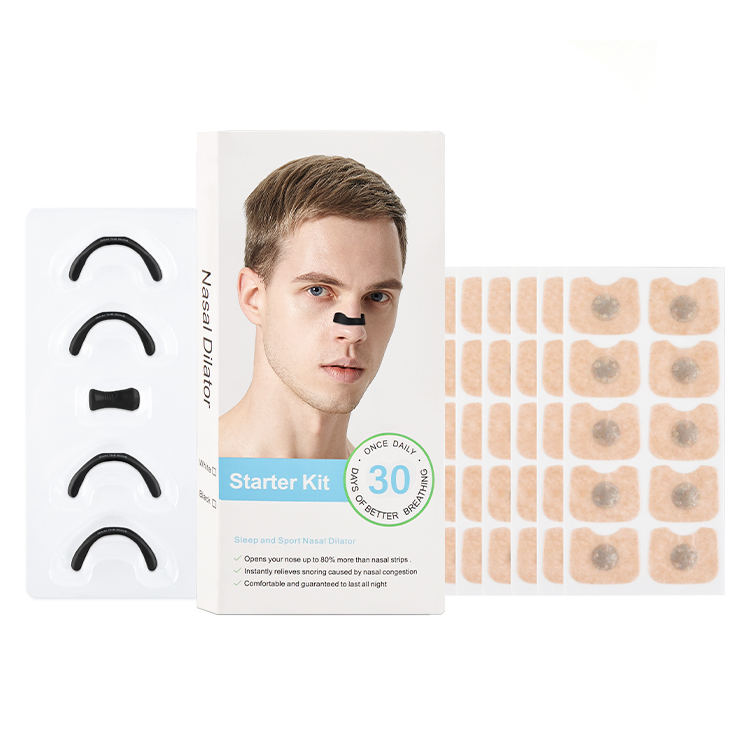Allereerst moet u weten dat zinkoxide-tape een stijve atletische tape voornamelijk gebruikt voor blessurepreventie en ondersteuning tijdens sport en fysieke activiteit. In tegenstelling tot elastische kinesiologietape, Het is onelastisch en inflexibel, ontworpen om gewrichten en spieren te ondersteunen.

Belangrijkste toepassingen van zinkoxide-verpakkingstape
Gezamenlijke immobilisatie en ondersteuning: Zinkoxide tape is ideaal voor het immobiliseren en fixeren van gewrichten om overmatige of onnodige bewegingen te voorkomen. Het is gunstig voor enkels, polsen, vingers en knieën. Door het bewegingsbereik van het gewricht te beperken, kunnen verstuikingen en herhalingsblessures worden voorkomen. Het tapen van een enkel na een verstuiking zorgt bijvoorbeeld voor externe stabiliteit, wat cruciaal is tijdens het genezingsproces.
Blaren en schaafwonden voorkomen: Deze zinkoxide tape tegen blaren kan rechtstreeks op de huid worden aangebracht die aan hoge wrijving wordt blootgesteld, waardoor een beschermende barrière ontstaat. Sporters gebruiken het vaak op hun voeten of handen om blaren door schoenen of uitrusting te voorkomen.
Vaste verbanden: Vanwege zijn sterke hechtende eigenschappen kan zinkoxide-verpakkingstape ook worden gebruikt bij eerste hulp om wondverband en pleisters stevig op hun plaats te houden.
Gezamenlijke decompressie: Het aanbrengen van de zinkoxide-tape in een specifiek patroon kan helpen bij het verlichten van pijn aan gewonde gewrichten door de druk te verminderen en spanning te verplaatsen.
Kan je zinkoxide tape direct op de huid aanbrengen?
Ja, u kunt witte zinkoxidepleister rechtstreeks op de huid aanbrengen. Het is voor dit doel ontworpen en wordt vaak gebruikt in verschillende toepassingen, waaronder sportgeneeskunde en eerste hulp.
Belangrijke overwegingen voor toepassing op de huid
Toepassingsgebieden: Zinkoxide-fixatietape is een stijve, niet-elastische tape die gewrichten stevig ondersteunt en fixeert. Het is ideaal voor het voorkomen van verstuikingen, het verbinden van gewonde gewrichten (zoals enkels of polsen) of het immobiliseren van verbanden.
Hechtsterkte: Witte zinkoxide tape is sterk en duurzaam, maar dit betekent ook dat u uiterst voorzichtig moet zijn bij het verwijderen ervan, vooral op een gevoelige of delicate huid. Te veel kracht uitoefenen kan huidbeschadiging veroorzaken, dus voorzichtigheid is geboden. Als alternatief kunt u onze pre-wrap tape gebruiken en deze om het betreffende gebied wikkelen voordat u de tape aanbrengt. Dit vormt een barrière om pijnlijk verwijderen te voorkomen.
Huidreacties: Sommige mensen kunnen nog steeds gevoeligheid of allergische reacties op de lijm ervaren. Verwijder de tape onmiddellijk als u roodheid, jeuk of blaarvorming ervaart.
Kortom, zinkoxide-fixatietape kan veilig rechtstreeks op de huid worden aangebracht en is een uitstekende keuze voor veilige, betrouwbare ondersteuning.
Is zinkoxide tape beter dan kinesiologie tape?
Nee, er is geen duidelijke superioriteit of inferioriteit tussen de twee. Zinkoxide-tape en kinesiologietape zijn fundamenteel verschillende hulpmiddelen die voor andere doeleinden zijn ontworpen. De “beste” keuze hangt volledig af van uw behoeften en het type ondersteuning of behandeling dat u wenst.
Hier volgt een overzicht van de belangrijkste verschillen om u te helpen beslissen welke het beste bij u past:
Zinkoxide tape (Sporttape)
Primair gebruik: Immobilisatie en stevige ondersteuning.
Kenmerken:
Niet-elastisch: Dit type tape heeft geen elasticiteit. De belangrijkste functie ervan is het beperken van bewegingen om blessures te voorkomen of te beschermen.
Sterke kleefkracht: Zinkoxide-fixatietape heeft een krachtige, langdurige kleefkracht, meestal op basis van zinkoxide, die zelfs tijdens intensieve lichaamsbeweging en transpiratie een stevige fixatie biedt.
Meest geschikt voor:
Gewrichtsverstuikingen: Door een verstuikte enkel, pols of knie te tapen, voorkom je dat deze verder omkrult of verdraait.
Blessurepreventie: stevige ondersteuning bieden aan een kwetsbaar gewricht vóór activiteiten met hoge impact.
Een gebied immobiliseren: het bewegingsbereik van een gewricht beperken om tijd te geven voor genezing.
Huidbescherming: Vormt een beschermende barrière op plaatsen die gevoelig zijn voor blaren, zoals de handen of voeten.
Kinesiologie Tape
Primair gebruik: Verlicht pijn, bevordert de bloedsomloop en ondersteunt de spieren zonder de bewegingsvrijheid te beperken.
Kenmerken:
Elasticiteit: De kinesiologietape is ontworpen om mee te rekken en te bewegen met het lichaam, waarbij het de elasticiteit van de huid nabootst voor een volledige bewegingsvrijheid.
Lifting: Bij correct gebruik veert de tape terug en tilt deze de huid voorzichtig op, wat naar verluidt de druk op het onderliggende weefsel verlicht.
Beste toepassingen:
Spierpijn: Verlicht pijn door spierpijn, verrekkingen of overbelasting.
Vermindering van zwellingen: Verbetert de bloedsomloop en lymfedrainage, waardoor zwellingen worden verminderd.
Verbetert de proprioceptie: geeft sensorische feedback aan de hersenen, waardoor je je beter op bewegingen kunt concentreren en een betere houding kunt aanhouden.
Revalidatie: Biedt zachte ondersteuning tijdens fysiotherapie-oefeningen om het herstel te bevorderen.

